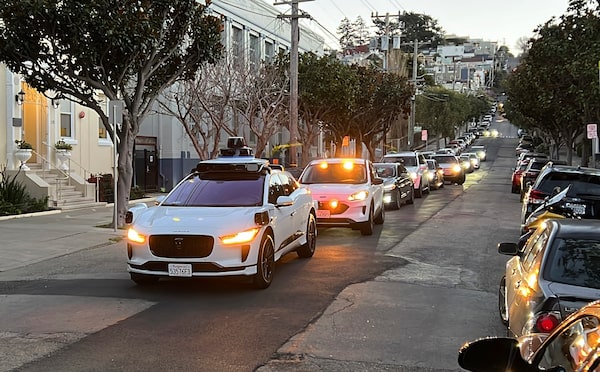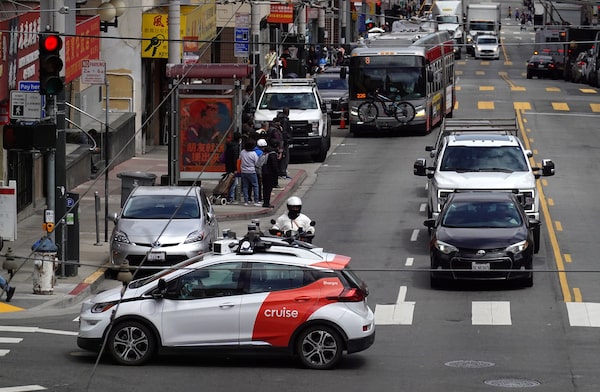
A Waymo driverless taxi stops on a street in San Francisco for several minutes because the back door was not completely shut, while traffic backs up behind it, on Feb. 15, 2023.Terry Chea/The Associated Press
For almost two decades, experts and everyday citizens have been wondering when the era of the driverless car would begin. They can stop. It began on August 10, 2023. That’s the day the California Public Utilities Commission (CPUC), which regulates taxi and ride-hail services, voted 3 to 1 in favour of awarding autonomous vehicle (AV) companies Waymo and Cruise with driverless deployment permits that allow them to offer paid fully autonomous ride-hailing services in their cars day and night in San Francisco. The permits also place no limit on the number of robotaxis they can put on the road.
Robotaxis exist on U.S. roads currently. They are allowed to offer paid rides on the streets of Austin and Phoenix day and night. In San Francisco, General Motors-owned Cruise charges riders for fully driverless robotaxis but only at night and Alphabet-backed Waymo offers free driverless rides for employees and friends of employees and charges for rides with a human safety operator in the vehicle.
But the streets of San Franscisco during the daytime is a whole new ball game. It is a formidable challenge compared to the sunny, flat streets of Austin and Phoenix. It sits on a small peninsula and is defined by narrow streets, steep hills, foggy weather, rain, trolleys, cyclists and pedestrians. There is limited curb space and a proliferation of double parking. By allowing Waymo and Cruise to offer 24/7 paid service, the CPUC is giving them the opportunity to create a regulatory template that can be applied in other North American cities with temperate climates (snow is bad for AVs). From the perspective of Waymo and Cruise, San Francisco is the perfect place to evolve autonomous vehicle ride-hailing services at hyper speed.
The companies plan to begin this within the month.
David Zipper, a visiting Fellow at the Harvard Kennedy School’s Taubman Center for State and Local Government told the Washington Post that San Francisco is the ”canary in the coal mine for the country and the developed world. We’re talking about monumental impacts on how our streets work, environmental emissions, on sprawl, on equity. The potential impacts just can’t be overstated.”
Robotaxis insurance has been covered by third parties. In 2017, Waymo partnered with the insurance startup Trov.

A Chevrolet Cruise autonomous vehicle with a driver moves through an intersection on June 8, 2023 in San Francisco.Justin Sullivan/Getty Images
Not everyone shares the enthusiasm. Many citizens hate robotaxis. In fact, after a group of grassroots protesters called “Safe Street Rebels” discovered they could temporarily disable AVs by planting orange traffic cones on the hoods of robotaxis, they held “the week of the cone” in June to protest against Waymo and Cruise. San Francisco first responders oppose the CPUC decision, arguing that robotaxis are a menace. The San Francisco Fire Department has identified more than 55 incidents when robotaxis interfered with their efforts. Fire Chief Jeanine Nicholson is on the record claiming the technology is “not ready for prime time.”
The San Francisco Taxi Workers Alliance and the Alliance for Independent Workers fear the harm to workers. They held a news conference in June and summed up their position, “We must halt this AI insane profit drive to destroy the lives of Taxi drivers, UBER-LYFT workers and all delivery workers and make this an Amazon special zone for their plan to eliminate millions of workers and their jobs while profiting the billionaire class.”
SF Gate writer Ariana Bindman sums up the anger, writing, “The ‘rigorous’ training that these cars must undergo each day is still annoying – and endangering – San Franciscans who didn’t sign up to become the multibillion-dollar companies’ unpaid lab rats.”
Waymo and Cruise counter these criticisms by citing the damage caused by human driving error, noting that nearly 43,000 people died on U.S. roads in 2022. Robotaxis, they argue, are safer. In Waymo’s million miles of fully autonomous driving, they have had “no reported injuries, no collisions involving pedestrians or cyclists.” When benchmarked against human drivers, Cruise claims its cars were involved in 54 per cent fewer collisions and 73 per cent fewer collisions with meaningful risk of injury.
Supporters, some of them whom are people who have disabilities, extolled the virtues of the robotaxis. Jessie Wollensky, who identifies as blind, told the CPUC hearing, “When I get into a Waymo vehicle, I feel not only that I’m able to get to where I need to be on my own terms, which is huge, but I’m able to do so without the fear of being harassed, groped, assaulted or attacked.”
Robotaxis have good safety records, but they can also behave strangely. Robotaxis may ”brick” (come to a dead stop) and trigger traffic mayhem. The day after the CPUC decision, CBS Bay Area reported that as many as 10 Cruise robotaxis were “paralyzed on two narrow streets in North Beach Friday around 11 p.m.”
Joe Eskenazi, a writer with the Mission Local, wondered “if it was a victory lap.” Eskenazi noted that, though CPUC granted the permits, local legislation does not allow “fleet charging as an accessory use on public charging stations.” That means Waymo and Cruise will have to deal with hostile local government to find places to plug their fleets in.
Despite all the potential turbulence, the CPUC decision remains an unquestionable victory for those backing driverless autonomous vehicles. Waymo and Cruise, who have invested billions without seeing much return, now have San Francisco at their disposal 24/7. It’s the perfect urban environment in which to evolve their technology. It may not be long before other American cities have similar arrangements. What seemed impossible in 2000 is now inevitable. Mark August 10, 2023 in your calendars. That’s the day the driverless future began.
 Andrew Clark
Andrew Clark